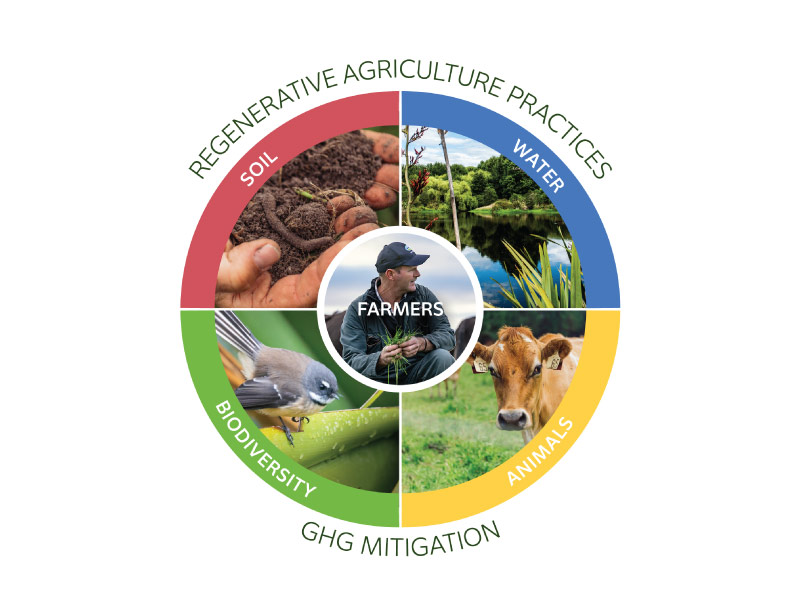As a world leader in grass-fed pasture-based farming, many regenerative agriculture practices are simply how we farm.
Regenerative Agriculture is about continuous improvement over time. Fonterra uses data to help inform and improve practices fit for the specific context in which farms operate and can contribute to improved outcomes for our natural resources.

Our Framework
We've shaped our regenerative agriculture framework around the four well-recognised natural resources that and are vital to the ongoing success of Fonterra and our farmers shareholder’s ongoing success, and can contribute to a reduction in GHG emmisions intensity. At the centre of our model are Fonterra farmers - with the knowledge and expertise to manage their natural ecosystems.
Our Resources
All Fonterra farmers are on their own journey. Each farm is unique and with their own set of challenges. We’ve spoken to some of our farmers about how they are helping to protect key resources and outcomes through the practices they use on their farms.
Soil
Water
Animal
Biodiversity
Soil
Hear from Jason Christensen, Fonterra farmer on the importance of soil and how he manages it on his farm.
Soil underpins the health of farming environments with different challenges in different countries and regions.
Water
Hear from Ian and Keith Trotter, Fonterra farmers shareholders on the benefits they have seen on their farm by protecting their waterways.
Water is an essential resource that we rely on.
Protecting on-farm waterways through excluding stock, creating riparian buffer zones and optimising nutrient use to reduce excess run-off, all contribute to better water quality2, the key challenge farmers face in New Zealand.
Animal
Hear from Ian and Keith Trotter, Fonterra farmer shareholders, on how on-farm practices on their farms helps to supports healthy ecosystem, and how data and technology can be is used to monitor each cow to help ensure the cows are healthy and well cared for.
Healthy, cared for animals are the heart of every dairy farm.
Prioritising healthy cows through animal management is a critical component of farm sustainability and performance.
Biodiversity
Hear from Jason Christensen, Fonterra farmer, about some of the native species on his farm, how they work together, and the importance of protecting these for future generations.
New Zealand is home to some unique biodiversity.
Increased biodiversity across the farming system helps to improve soil fertility, nutrient recycling and pollination, and ultimately creates ecosystems which are more resilient against climate change3. Coupled with healthy soil, improved biodiversity provides more opportunity for carbon capture4.
1) Wedderburn, L et al. (2020). Pasture-fed livestock production and products: Science behind the narrative. AgResearch Internal Report.
Report Number RE450/2020/071.2) Farm management for healthy waterways, including stock exclusion | NZ Government
3) Christianah, D. O., & Folarin, I.O. (2024). The Role of Biodiversity in Agricultural Resilience: Protecting Ecosystem Services for Sustainable Food Production. International Journal of Research Publication and Reviews, Vol 5, no 10, pp 1560-1573
4) Mekonnen, H. D., & Sintayehu, W. D. (2018). The role of biodiversity and ecosystem services in carbon sequestration and its implication for climate change mitigation. International Journal of Environmental Sciences & Natural Resources, 11(2), 555810.
Important Disclaimer: NZMP (and the Fonterra Group) makes no representations or warranties in respect of the information contained on the NZMP website or on this particular webpage, including representations or warranties (express or implied) concerning fitness for purpose or appropriateness (including whether such information can be used in compliance with any applicable jurisdiction) in relation to the use in connection with the marketing, promotion and sale of any third party products. Without limiting the foregoing, any use of, or reliance on, the information contained on the NZMP website or on this particular webpage is not the responsibility of NZMP or the Fonterra Group.
*96% is an average calculated on an ‘as consumed’ basis. The average is measured over our previous three seasons data. Grass-fed means cows mainly grazing on grass and crops in paddocks where they roam. Visit NZMP.com/grass-fed for more information.


Healthy soil helps provide the best conditions for plant growth, encourages biological activity, stores water and resists erosion1. Grazed pastures have more organic matter in the soil and can hold more carbon content than cultivated fields1.